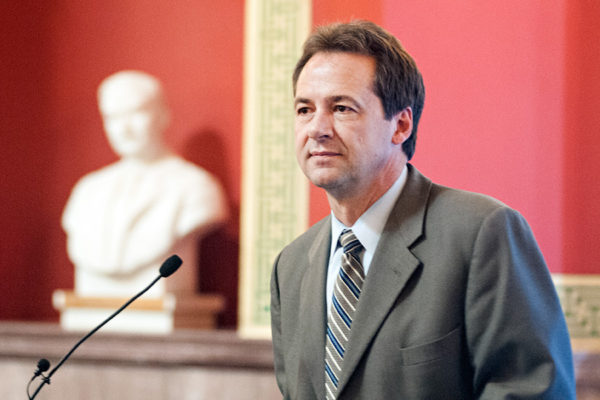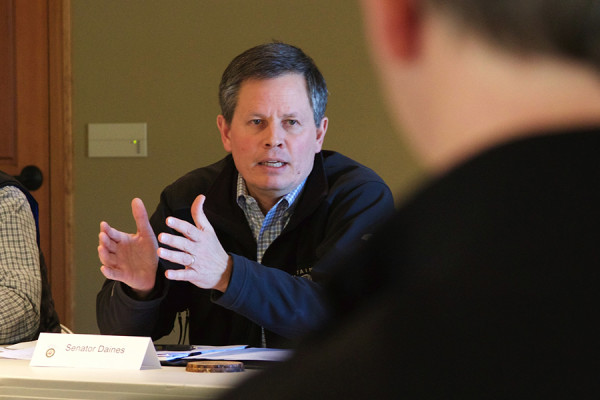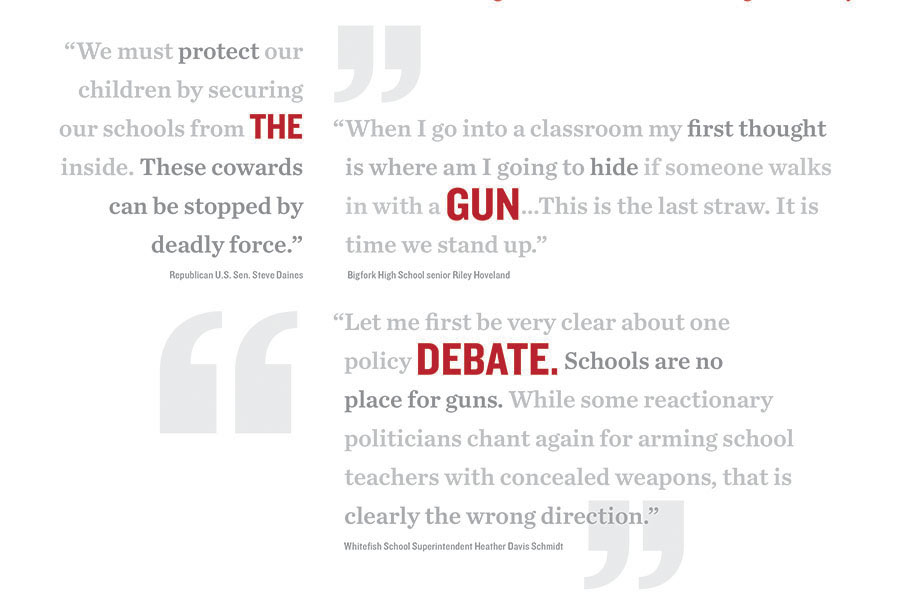Riley Hoveland isn’t your typical Montana teenager.
The politically savvy senior at Bigfork High School will attend Harvard this fall and plans on majoring in government studies. She’s counting the days to her 18th birthday because she’ll reach voting age just in time for the midterm election. Her silver Mercedes bears a “Bernie Sanders” bumper sticker. Her iPhone case says “feminist.”
“I’m definitely in the minority at Bigfork for my politics,” she acknowledged. “But gun violence shouldn’t be a partisan issue. It’s a people issue.”
Despite holding views that often run counter to the conservative streak that defines Flathead County, Hoveland said students’ responses to the Feb. 14 mass shooting at Marjory Stoneman Douglas High in Parkland, Florida, have been more unifying than divisive; less political and more sympathetic, striking a tone that rises above partisan politicking and is emboldening a generation.
The recent Florida shooting affected Hoveland dramatically, and while she remains devastated by the tragedy, the response of outspoken Parkland students like David Hogg and Emma Gonzalez gave her hope and inspired her to stand up and make her voice heard.
Like most Montana teens, Hoveland grew up around guns and gun culture. She’s also grown up on a social landscape in which gun violence is commonplace, and her entire life so far has been bookended by mass school shootings, with the Columbine High School massacre occurring one year before she was born.
It’s a reality she can’t shake, even in the idyllic, lakeside enclave of Bigfork.
“When I go into a classroom, my first thought is where am I going to hide if someone walks in with a gun,” she said. “We have grown up in an age where shootings are the normal, and now we are at the age where we can do something about it. This is the last straw. It is time we stand up.”

The wave of student activism surrounding gun violence spread quickly following the Florida shooting one month ago, and it has made its way into Montana and the heart of gun country. At Bigfork High, Hoveland has taken on the onus of organizing a planned student walkout to memorialize the 17 students and faculty members who were fatally gunned down in Florida.
The walkouts are unfolding across the country at 10 a.m. on March 14, after the Beacon went to print, and are scheduled to last for precisely 17 minutes, a timeframe meant to represent the shooting victims. They also serve as a prelude to a march on Washington, D.C., planned for March 24 that could bring hundreds of thousands of students to the capital, where political acrimony over more stringent gun-control measures has reached a fever pitch.
Many more students are expected to join actions on their campuses, coordinated with student leaders and school administrators, who are seeking a middle ground that acknowledges and supports students engaged in protests while ensuring rules are followed, students remain safe and the events are not politicized.
In Flathead County, school districts are not penalizing students for participating in the walkout, so long as they obey school rules, and have adopted a range of strategies to ensure the events are inclusive and safe. High schools in the Flathead Valley are participating in or acknowledging the Florida victims in some shape or form on March 14.
In a message to families, Kalispell Public Schools Superintendent Mark Flatau said the district was not sanctioning a political event and issues of gun control and other hotly contested national topics are not the focus.
“This is an opportunity for student voice to be recognized in collaboration and cooperation with school administration,” he wrote.
Glacier High School Principal Callie Langohr said student leadership would deliver brief remarks about the purpose of the walkout before reading brief biographies about each of the 17 victims in Parkland, Florida. Organizers will play a tribute song written and sung by students of Marjory Douglas High School before returning to class.
“The students who have organized the walkout are respectful of everyone’s right to participate or not participate,” she said.
Glacier High School student Harrison Rennie, who helped organize the walkout at his school, said the goal is to join a unified voice and honor the slain students and staff while also standing up for “our right to attend school in a safe environment, which includes our legislators looking at all possible solutions and taking action to prevent further tragedies in the future.”
Too often, he said, elected leaders use “empty dialogue” when discussing measures to make schools safer, and the recent student movement has given young people a meaningful platform to express their concern.
“They need to be willing to look past party lines that have been created in the past and be open to all solutions,” Rennie said.
Hoveland said she took care to carefully craft the verbiage of the flyers she distributed advertising the walkout, assuring participants that it was a memorial, not a protest.
Other area students are opting to participate in the walkout as a memorial, but planned on putting their support for Second Amendment rights and opposition to stricter gun control on display.
“Our primary goal is to honor the victims of the school shooting in Florida,” Columbia Falls High School senior Braxton Shewalter said. “But we also want to support our right to own guns and show that you’re not to blame for these tragedies just because you oppose gun control.”
Across the nation, other student groups are using the walkout as a platform to press lawmakers to pass stricter gun control laws, according to EMPOWER, the group organizing the action.
Among their demands, the advocates want Congress to ban assault weapons, require universal background checks before gun sales, and pass a gun violence restraining order that would allow courts to disarm individuals who display warning signs of violent behavior.
Hoveland said she’s eager to depolarize the issue politically while advocating for solutions to gun violence.
“I have noticed bipartisan support when I describe it as a memorial first,” Hoveland said. “That seems to invite conversation and discussion, because nobody is pro-death. Nobody is pro-killing-students.”
Still, the Florida school shooting has unleashed a maelstrom of political discourse and rhetoric proving that the solutions to gun violence are as polarizing as ever.
“Some students are very against the walkout because they think we are taking a political stance,” said Columbia Falls High School sophomore Kailey Schrader, who is organizing a walkout at her school. “We are planning this as a memorial, not a political statement. But I think there is a line between students who are very much against what we are doing and students who understand and want to take part in it and have their voices heard. We just want to feel safe in our communities and our classrooms. Being in our shoes, being a student is scary because we know this can happen.”
The schism is even more prominent in political circles, with state and federal lawmakers firmly divided on measures to curb gun violence in a culture where mass shootings are so commonplace.
Montana Democratic Gov. Steve Bullock brought his concerns to the White House late last month, when he was among a group of governors who met with President Donald Trump to discuss gun violence on the heels of the Florida shooting. He advocated for gun-safety laws, telling Trump that he is approaching the issue as a governor, a gun owner, a parent, and as a victim.
“I had a nephew, shot and killed — an 11-year-old — on a playground,” Bullock told the president, referring to a fatal shooting in Butte in 1994, in which his nephew, Jeremy, was the unintended victim.

Bullock, serving his second term as governor, said he’s lowered the state Capitol’s flag to half-staff 43 times during his five-year tenure, 12 of them to recognize mass shootings.
“It’s almost, on the one hand, to the point that we’re getting desensitized,” Bullock said. “But on the other hand, here is a moment where everybody is talking, where we can hopefully start saying, ‘What could actually meaningfully impact this, not just for today, but for the future?’”
Gun control remains one of the trickiest political issues in Montana, where firearms are a part of hunting culture and the Second Amendment is sanctified. Coming out too strongly in favor of even the least aggressive forms of gun control can disenfranchise a politician or candidate from the voter base.
In each of Montana’s past four legislative sessions, there’s been a bill addressing the presence of guns in schools, ranging from opening up carry to anyone with a concealed permit to easing student penalties for having fake guns on school grounds.
One of the more controversial ideas to improve school safety is to arm teachers and train them to respond to a school shooting with lethal force. It’s an idea that has garnered support and equal parts opposition, including criticism from a victim of gun violence in a Montana school.
In 1986, John Moffatt survived a school shooting at Fergus High School in Lewistown, where he worked as the vice principal. More than 30 years later, he is still advocating for stricter gun control laws, and last legislative session he opposed a bill allowing school district employees with valid concealed weapons permits to carry concealed handguns in schools.
The bill, House Bill 385, was co-sponsored by Flathead-area representatives Derek Skees and Matt Regier, but was rejected on a 56-44 vote, with 15 Republicans and all 41 House Democrats voting against the measure.
“Guns in the hands of law-abiding citizens stop criminals from killing people,” Skees, a Republican, said. “It’s that simple. That’s what this bill is about. It’s not about crazy people owning guns.”
Moffatt testified against the bill before the House Judiciary Committee, recounting the harrowing details of the shooting. He was shot once through the abdomen by a 14-year-old freshman who murdered a substitute teacher before turning his .44 Magnum on Moffatt.
Hearing the gunshot that killed the teacher, Henrietta Smith, Moffatt said he was running up a flight of stairs to check on the classroom when, turning a corner, he came face to face with the armed student.
Moffatt doesn’t believe being armed could have altered the tragedy.
“As a victim of gun violence and a former school administrator, I know all too well how easy access to a loaded gun can make everyday disputes deadly. I also know there was absolutely nothing I could have done if I had been armed at that time,” he said. “Bringing hidden, loaded guns into our children’s classrooms is not the answer — it only takes one mistake for something to go horribly wrong.”
While Montana law already allows individual school districts to decide whether to permit school employees to carry firearms in schools, it’s extremely rare, with only schools in Lima, Belfry and Custer having allowed it.
A bill to more broadly expand conceal-and-carry laws into Montana schools will almost certainly resurface at the 2019 session, according to Kalispell Rep. Frank Garner, a Republican who voted against the measure last session. Garner previously served as Kalispell’s police chief.
“It’s already legal in this state for school districts to authorize people other than law enforcement to carry firearms under certain conditions in the classrooms,” he said. “It’s a matter of local control and local decision-making.”
Instead of expending its energy on another bill to arm teachers, Garner suggested the Legislature focus on how to fund safety improvements at Montana schools, some of which are lacking basic safety standards, and on investing more money in mental-health intervention.
“I think that has to be part of the conversation,” he said.

Flathead County Sheriff Chuck Curry said his office has received inquiries from local school districts about how a plan to train and arm school employees could logistically be carried out. He’s skeptical about its efficacy, and isn’t sure where school employees would receive training.
“It wouldn’t be from our office. My concern from a public safety standpoint is what training and qualification levels would be in place,” Curry said. “As law enforcement, we are routinely training. We are schooled in use of force and the escalation of force. There is a lot more to it than giving a first-grade teacher a gun to put in her purse. It’s not as simple as it seems. You can’t just hand out guns and say, ‘Go shoot the bad guys.’”
And yet it’s a step for which Montana’s congressional delegation has voiced varying degrees of support, including both U.S. Sen. Steve Daines, a Republican, and Democratic U.S. Sen. Jon Tester.
“We must protect our children by securing our schools from the inside,” Daines said. “These cowards can be stopped by deadly force.”
Tester said local school districts should have the right to make the decision if they believe it is the right fit for a community.
“If a local school board, with the support of the local community, thinks they need to have someone with a gun in the school, whether it’s a teacher or somebody else, they need to make that decision,” Tester said. “As a former teacher, I’m not certain giving teachers guns is the right action. But if the school board feels they have the right people to do that on their staff, I’d certainly defer to them.”
Bullock isn’t so sure, telling Trump that he would prefer to see expanded background checks and improvements to the National Instant Criminal Background Check System. He urged the president to consider so-called “red-flag laws” that allow law enforcement and families to have firearms removed from individuals they perceive as an imminent threat, and applauded him on his statements suggesting bump stocks and high-capacity magazines could be banned. And he encouraged that caution be exercised in allowing or promoting guns in schools, drawing on his firsthand experience as the state’s Attorney General overseeing the Montana Law Enforcement Academy.
“I want to make sure if somebody is armed in a school that they have that training that we know that he or she — it’s much more, as I think you recognize, than just carrying concealed — that they have that training that I as a parent can say that this person under pressure will know what to do with a firearm before we start introducing the firearms in to our schools,” Bullock said.
Whitefish School District Superintendent Heather Davis Schmidt said she adamantly opposes guns in schools, writing: “Let me first be very clear about one policy debate. Schools are no place for guns. While some reactionary politicians chant again for arming school teachers with concealed weapons, that is clearly the wrong direction.”
Numerous area schools participate in training exercises that simulate active-shooter scenarios, including “Run, Lock and Fight” programs conducted by area law enforcement.
For Hoveland, growing up in a gun-owning family and around an avid hunting culture, she doesn’t feel unsafe around firearms. But she knows that mental-health issues and bullying can have a dramatic impact on young people, and said she’s encouraged by the wave of student activism and the increased dialogue among her peers.
“It feels like the adults haven’t been doing anything about this, and that is what compelled me to stand up,” she said. “The people of my generation are speaking up and we deserve to be heard.”
